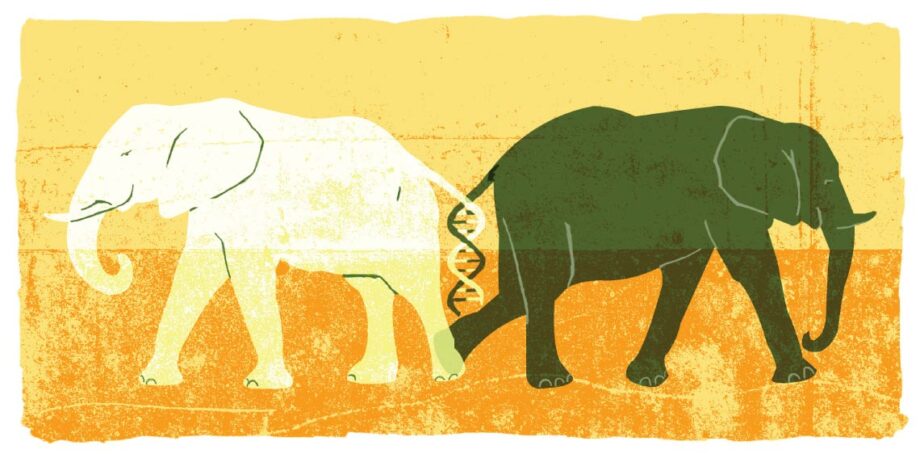February 27, 2013 — The revolution in genetics — each year, faster, cheaper, easier tools for reading DNA — has spread to far-flung corners of the map. While the high-tech sequencing machines enabling this may be confined to labs in wealthy countries, the genetic material that will pass through these machines is being gathered by field biologists across the planet’s savannahs, steppes and rainforests.
In the DNA era, few are the conservation biology projects without a genetic component. Scientists are using genetics to monitor animal populations, piece together their histories and make predictions about their futures in a rapidly changing world. They’re using genetic markers to select the best individuals for reintroduction programs, to determine causes of decline and to design better conservation plans — taking into account, for instance, how much genetic diversity a population needs to thrive.
These are powerful, invaluable tools, and they’ve afforded a new level of precision to a science that needs it. (Is an otter reintroduction effort a true success if the population grows but nearly all the offspring came from one very virile male?) But they’ve also introduced an element of confusion. The more we look under the hood, the more we see things that aren’t what they seemed. Take elephants. Any kid who’s been to the zoo or the natural history museum could once distinguish an African elephant from its Asian cousin. Except now we find, thanks to DNA extracted from elephant blood, that the animals we’ve long lumped as African elephants are in fact two species. Which means species counts have been flawed and possibly other conservation efforts, too.
Genetic analysis is turning up such “cryptic species” — species that look the same to us but turn out to be very different genetically — all over the place. Biologist Daniel Janzen, who’s been using a technique called DNA barcoding to identify cryptic insect species in a Costa Rican forest, once believed the area held roughly 9,000 species of moths and butterflies. Since discovering that many of them only look identical until you read their DNA, he thinks the number is closer to 15,000. In such cases, species-specific conservation programs may miss the mark.
In a story in Wired magazine last year, I wrote about a controversial plan to save the Devils Hole pupfish, a highly endangered fish (there are about 75 left) that lives only in one desert aquifer. Andrew Martin, a biologist at the University of Colorado Boulder, believes the species’ gene pool contains too many bad mutations; the only way to save it, he says, is to revive its genome with DNA from a closely related fish. To save a species by making it a hybrid is shocking when you first hear it, but Martin doesn’t believe that species boundaries are quite as clear-cut as we learned in school. As I wrote in Wired, he “prefers to treat the species concept as a hypothesis, a way to make predictions. But that mode of thinking doesn’t jibe with the legal framework for preventing extinction, which revolves around the existence of clearly delineated species.”
For years, conservation has centered on species: the gray wolf, the spotted owl, the Devils Hole pupfish. We go about protecting ecosystems by first protecting the singular species that live there. So what happens when that “singular” species turns out to be two or six or 10 genetically distinct types of organisms, each with its own singular role in the environment?
As we tunnel deeper into the DNA era, we need a new, more flexible way to think about conservation, one not so tied to the increasingly unruly concept of “species.” Genetics has given us potent technology for protecting the world around us. It’s time for conservation policies that are dynamic and effective enough to hold up. It’s time to think critically and deeply about what, exactly, we want to conserve.
The 20th century answer was to save species X as it exists right here and now — an insufficient concept. (Nature changes, whether we want it to or not.) In the 21st century, as we confront massive, human-caused changes to climate and to global land use, we need a new vision for conservation. Are we protecting genetic diversity? Evolutionary potential? Ecosystemwide biodiversity? Something else? Without a clear answer, conservation as a whole may be doomed. And that’s not something we can accept — for the sake of species, genomes, ecosystems, the planet and ourselves.
Editor’s note: The views expressed here are those of the author and not necessarily of Ensia. We present them to further discussion around important topics. We encourage you to respond with a comment below, following our commenting guidelines, which can be found here. In addition, you might consider submitting a Voices piece of your own. See Ensia’s “Contact” page for submission guidelines.
Ensia shares solutions-focused stories free of charge through our online magazine and partner media. That means audiences around the world have ready access to stories that can — and do — help them shape a better future. If you value our work, please show your support today.
Yes, I'll support Ensia!

https://theconversation.edu.au/genetics-to-the-rescue-hybrid-mountain-pygmy-possums-born-on-mt-buller-6134
Also, I agree that we need to think about what we want to achieve in conservation, and how to achieve that efficiently:
http://mickresearch.wordpress.com/2012/06/06/conservation-triage-and-how-the-public-values-species/
It is a paradox. The fish are genetically identical, though hatcheries -- the fish ecologists now say -- can wreck remnant wild populations of salmon even as they replace populations lost to big dams.